빈 스코프란?
- 스프링 빈이 스프링 컨테이너의 시작과 함께 생성되어서 스프링 컨테이너가 종료될 때까지 유지된다고 알고있다.
- 이것은 스프링 빈이 기본적으로 싱글톤 스코프로 생성되기 때문이다.
- 스코프는 번역 그대로 빈이 존재할 수 있는 범위를 뜻한다.
스프링이 지원하는 다양한 스코프
- 싱글톤 : 기본 스코프, 스프링 컨테이너의 시작과 종료까지 유지되는 가장 넓은 범위의 스코프다.
- 프로토타입 : 스프링 컨테이너는 프로토타입 빈의 생성과 의존관계 주입까지만 관여하고 더는 관리하지 않는 매우 짧은 범위의 스코프다.
- 웹 관련 스코프 :
- request : 웹 요청이 들어오고 나갈 때 까지 유지되는 스코프다.
- session: 웹 세션이 생성되고 종료될 때까지 유지되는 스코프다.
- applcation : 웹의 서블릿 컨텍스와 같은 범위로 유지되는 스코프다.
컴포넌트 스캔 자동 등록
@Scope("prototype")
@Component
public class HelloBean() {}
수동 등록
@Scope("prototype")
@Bean
PrototypeBean HelloBean() {
return new HelloBean();
}
프로토타입 스코프
- 싱글톤 스코프의 빈을 조회하면 스프링 컨테이너는 항상 같은 인스턴스의 스프링 빈을 반환한다.
- 반면에 프로토타입 스코프를 스프링 컨테이너에 조회하면 스프링 컨테이너는 항상 새로운 인스턴스를 생성해서 반환한다.
싱글톤 빈 요청
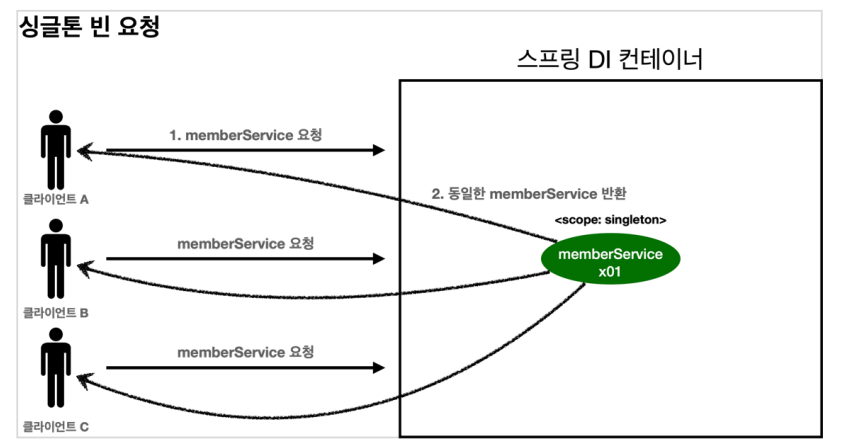
- 싱글톤 스코프의 빈을 스프링 컨테이너에 요청한다.
- 스프링 컨테이너는 본인이 관리하는 스프링 빈을 반환한다.
- 이후에 스프링 컨테이너에 같은 요청이 와도 같은 객체 인스턴스의 스프링 빈을 반환한다.
프로토타입 빈 요청 1
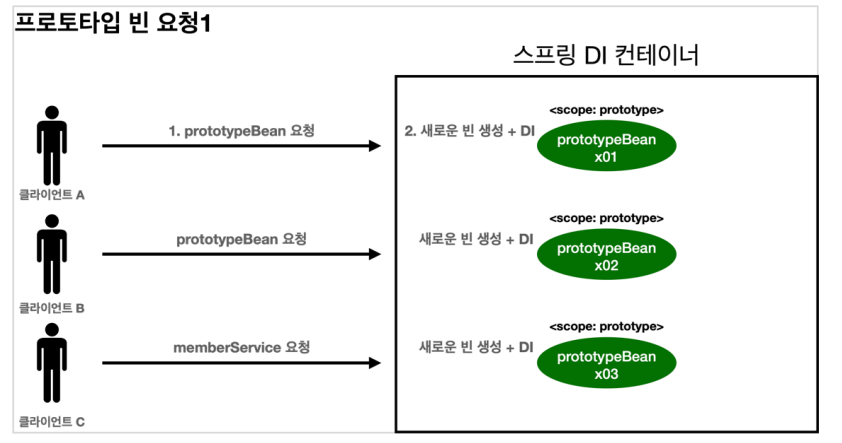
- 프로토타입 스코의 빈을 스프링 컨테이너에 요청한다.
- 스프링 컨테이너는 이 시점에 프로토타입 빈을 생성하고 필요한 의존관계를 주입한다.
프로토타입 빈 요청 2
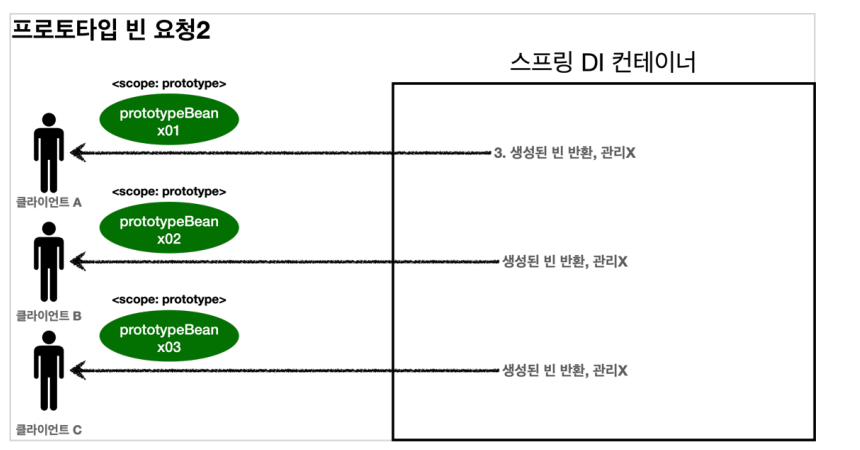
- 스프링 컨테이너는 생성한 프로토타입 빈을 클라이언트에 반환한다.
- 이후에 스프링 컨테이너에 같은 요청이 오면 항상 새로운 프로토타입 빈을 생성해서 반환한다.
프로토타입 스코프 정리
- 핵심은 스프링 컨테이너는 프로토타입 빈을 생성하고 의존관계 주입, 초기화까지만 처리한다는 것이다.
- 클라이언트에 빈을 반환하고 이후 스프링 컨테이너는 생성된 프로토타입 빈을 관리하지 않는다.
- 프로토타입 빈을 관리할 책임은 프로토타입 빈을 받은 클라이언트에 있다.
- 그래서 @PreDestroy 같은 종료 메소드가 호출되지 않는다.
예제 코드1 싱글톤 스코프
public class SingletonTest {
static class SingletonBean{
@PostConstruct
public void init() {
System.out.println("SingletonBean.init");
}
@PreDestroy
public void destroy() {
System.out.println("SingletonBean.destroy");;
}
}
@Test
void singletonBeanFind() {
//given
AnnotationConfigApplicationContext ac = new AnnotationConfigApplicationContext(SingletonBean.class);
//when
final SingletonBean singletonBean1 = ac.getBean(SingletonBean.class);
final SingletonBean singletonBean2 = ac.getBean(SingletonBean.class);
//then
assertThat(singletonBean1).isSameAs(singletonBean2);
ac.close();
}
}
실행 결과
SingletonBean.init
21:39:20.554 [main] DEBUG org.springframework.context.annotation.AnnotationConfigApplicationContext - Closing org.springframework.context.annotation.AnnotationConfigApplicationContext@1de5f259, started on Sat Mar 05 21:39:20 KST 2022
SingletonBean.destroy
예제 코드2 프로토타입 스코프
public class PrototypeBeanTest {
@Scope("prototype")
static class PrototypeBean{
@PostConstruct
public void init() {
System.out.println("PrototypeBean.init");
}
@PreDestroy
public void destroy() {
System.out.println("PrototypeBean.destroy");
}
}
@Test
void prototypeBeanFind() {
//given
AnnotationConfigApplicationContext ac = new AnnotationConfigApplicationContext(PrototypeBean.class);
//when
final PrototypeBean prototypeBean1 = ac.getBean(PrototypeBean.class);
final PrototypeBean prototypeBean2 = ac.getBean(PrototypeBean.class);
//then
assertThat(prototypeBean1).isNotSameAs(prototypeBean2);
ac.close();
}
}
실행 결과
PrototypeBean.init
PrototypeBean.init
21:42:26.533 [main] DEBUG org.springframework.context.annotation.AnnotationConfigApplicationContext - Closing org.springframework.context.annotation.AnnotationConfigApplicationContext@6404f418, started on Sat Mar 05 21:42:26 KST 2022
- 싱글톤 빈은 스프링 컨테이너 생성 시점에 초기화 메소드가 실행되지만 프로토타입 스코프 빈은 스프링 컨테이너에서 빈을 조회할 때 생성되고 초기화 메소드도 실해오딘다.
- 프로토타입 빈을 2번 조회했으므로 완전히 다른 스프링 빈이 생성되고 초기화도 2번 실행된 것을 확인할 수 있다.
- 싱글톤 빈은 스프링 컨테이너가 관리하기 때문에 스프링 컨테이너가 종료될 떄 빈의 종료 메소드가 실행되지만 프로토타입 빈은 스프링 컨테이너가 생성과 의존관계 주입 그리고 초기화 까지만 관여하고 더이상은 관리하지 않는다.
- 따라서 프로토타입 빈은 스프링 컨테이너가 종료될 때 @PreDestroy 같은 종료 메소드가 전혀 실행되지 않는다.
프로토타입 스코프 - 싱글톤 빈과 함께 사용시 문제점
- 스프링 컨테이너에 프로토타입 스코프의 빈을 요청하면 항상 새로운 객체 인스턴스를 생성해서 반환한다.
- 하지만 싱글톤 빈과 함께 사용할 때는 의도한 대로 잘 동작하지 않으므로 주의해야 한다.
스프링 컨테이너에 프로토타입 빈 직접 요청 1
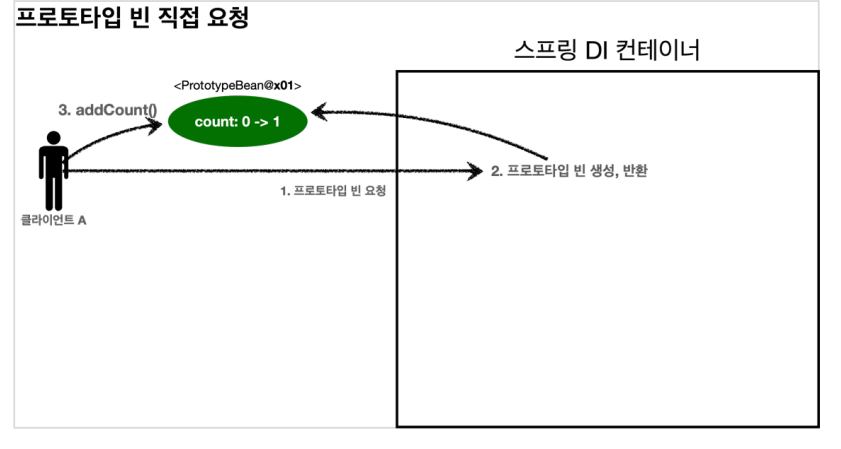
- 클라이언트A는 스프링 컨테이너에 프로토타입 빈을 요청한다.
- 스프링 컨테이너는 프로토타입 빈을 새로 생성(x01)해서 반환한다. 해당 빈의 count 필드 값은 0이다.
- 클라이언트는 조회한 프로토타입 빈에 addCount()를 호출하면서 count 필드를 +1 한다.
- 결과적으로 프로토타입 빈(x01)의 count는 1이된다.
스프링 컨테이너에 프로토타입 빈 직접 요청 2
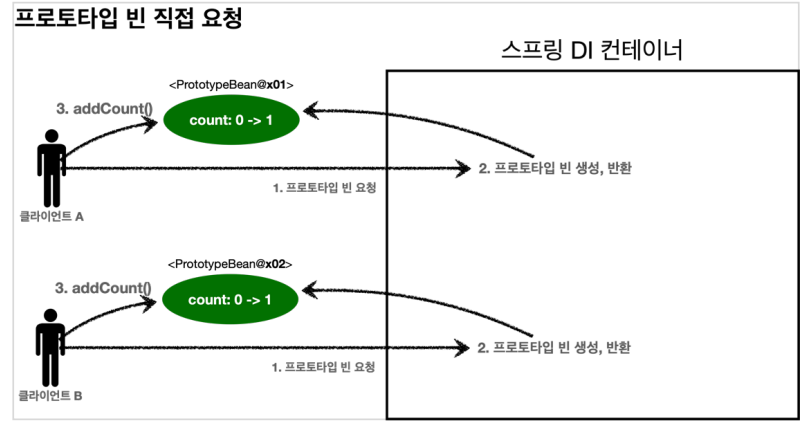
- 클라이언트B는 스프링 컨테이너에 프로토타입 빈을 요청한다.
- 스프링 컨테이너는 프로토타입 빈을 새로 생성해서 반환(x02)한다. 해당 빈의 count 필드 값은 0이다.
- 클라이언트는 조회한 프로토타입 빈에 addCount()를 호출하면서 count 필드를 +1 한다.
- 결과적으로 프로토타입 빈(x02)의 count는 1이 된다.
예제 코드
public class SingletonWithPrototypeTest1 {
@Getter
@Scope("prototype")
static class PrototypeBean{
private int count = 0;
public void addCount() {
count++;
}
@PostConstruct
public void init() {
System.out.println("PrototypeBean.init " + this);
}
@PreDestroy
public void destroy() {
System.out.println("PrototypeBean.destroy");
}
}
@Test
void prototypeFind() {
//given
final AnnotationConfigApplicationContext ac = new AnnotationConfigApplicationContext(PrototypeBean.class);
final PrototypeBean prototypeBean1 = ac.getBean(PrototypeBean.class);
prototypeBean1.addCount();
assertThat(prototypeBean1.getCount()).isEqualTo(1);
final PrototypeBean prototypeBean2 = ac.getBean(PrototypeBean.class);
prototypeBean2.addCount();
assertThat(prototypeBean2.getCount()).isEqualTo(1);
}
}
싱글톤 빈에서 프로토타입 빈 사용
- clientBean이라는 싱글톤 빈이 의존관계를 주입을 통해서 프로토타입 빈을 주입받아서 사용하는 예시
싱글톤 빈에서 프로토타입 빈 사용 1
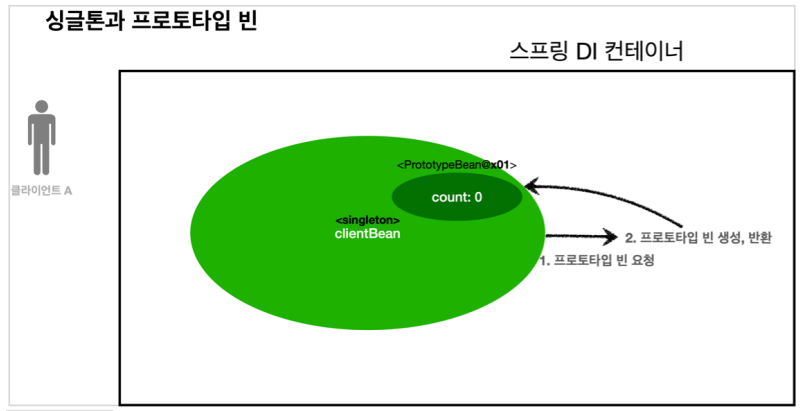
- clientBean은 싱글톤이므로 보통 스프링 컨테이너 생성 시점에 함께 생성되고 의존관계 주입도 발생한다.
- clientBean은 의존관계 자동 주입을 사용한다. 주입 시점에 스프링 컨테이너에 프로토타입 빈을 요청한다.
- 스프링 컨테이너는 프로토타입 빈을 생성해서 clientBean에 반환한다. 프로토타입 빈의 count 필드 값은 0이다.
- 이제 clientBean은 프로토타입 빈을 내부 필드에 보관한다.(정확히는 참조값 보관)
싱글톤 빈에서 프로토타입 빈 사용 2
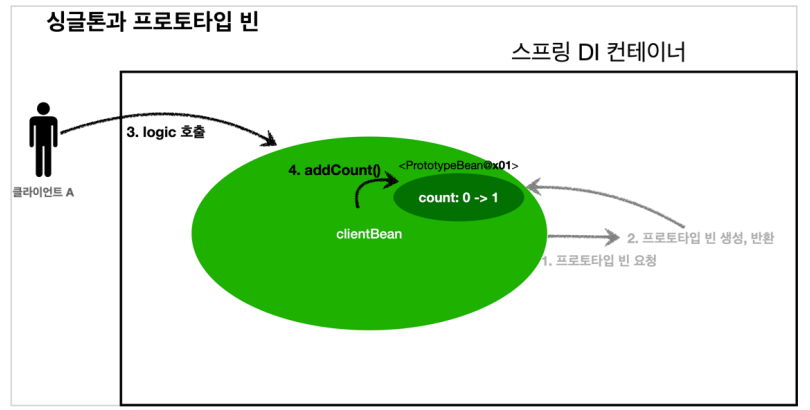
- 클라이언트 A가 clientBean을 스프링 컨테이너에 요청해서 받는다. 싱글톤이므로 항상 같은 clientBean이 반환된다.
- 클라이언트 A는 clientBean.logic()을 호출한다.
- clientBean은 prototypeBean의 addCount()를 호출해서 프로토타입 빈의 count를 증가한다. count값이 1이 된다.
싱글톤 빈에서 프로토타입 빈 사용 3
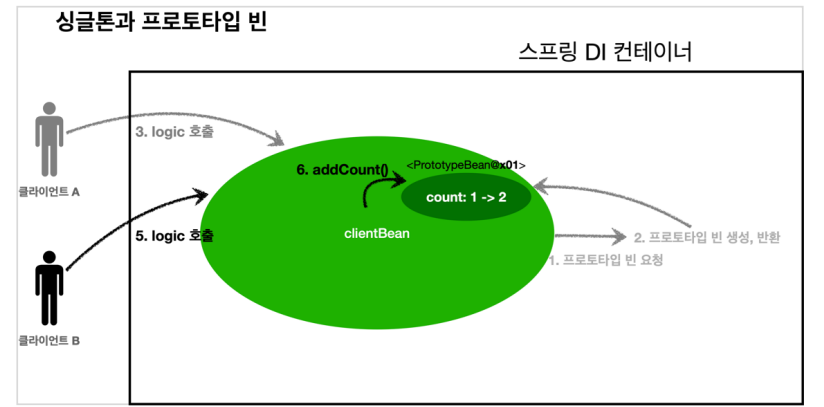
- 클라이언트 B는 clientBean을 스프링 컨테이너에 요청해서 받는다. 싱글톤이므로 항상 같은 clientBean이 반환된다.
- 여기서 중요한 점이 있는데 clientBean이 내부에 가지고 있는 프로토타입 빈은 이미 과거에 주입이 끝난 빈이다. 주입 시점에 스프링 컨테이너에 요청해서 프로토타입 빈이 새로 생성된 것이지 사용할 때마다 새로 생성되는 것이 아니다.
- 클라이언트 B는 clientBean.logic()을 호출한다.
- clientBean은 prototypeBean의 addCount()를 호출해서 프로토타입 빈의 count를 증가한다. 원래 1이였으므로 2가된다.
예제 코드
public class SingletonWithPrototypeTest1 {
@Getter
@Scope("prototype")
static class PrototypeBean {
private int count = 0;
public void addCount() {
count++;
}
@PostConstruct
public void init() {
System.out.println("PrototypeBean.init " + this);
}
@PreDestroy
public void destroy() {
System.out.println("PrototypeBean.destroy");
}
}
@RequiredArgsConstructor
static class ClientBean {
private final PrototypeBean prototypeBean;
public int logic() {
prototypeBean.addCount();
return prototypeBean.getCount();
}
}
@Test
void singletonClientUsePrototype() {
final AnnotationConfigApplicationContext ac = new AnnotationConfigApplicationContext(ClientBean.class, PrototypeBean.class);
final ClientBean clientBean1 = ac.getBean(ClientBean.class);
final int count1 = clientBean1.logic();
assertThat(count1).isEqualTo(1);
final ClientBean clientBean2 = ac.getBean(ClientBean.class);
final int count2 = clientBean2.logic();
assertThat(count2).isEqualTo(2);
}
}
- 스프링은 일반적으로 싱글톤 빈을 사용하므로 싱글톤 빈이 프로토타입 빈을 사용하게 된다.
- 그런데 싱글톤 빈은 생성 시점에만 의존관계 주입을 받기 때문에 프로토타입 빈이 새로 생성되기는 하지만 싱글톤 빈과 함께 계속 유지는 것이 문제다.
프로토타입 스코프 - 싱글톤 빈과 함께 사용시 Provider로 문제 해결
ObjectFactory, ObejctProvider
- 저장한 빈을 컨테이너에서 대신 찾아주는 DL(Dependency LookUp) 서비스를 제공하는 것이 바로 ObejctProvider다.
예제 코드
public class ObjectProviderTest {
@Getter
@Scope("prototype")
static class PrototypeBean {
private int count = 0;
public void addCount() {
count++;
}
@PostConstruct
public void init() {
System.out.println("PrototypeBean.init " + this);
}
@PreDestroy
public void destroy() {
System.out.println("PrototypeBean.destroy");
}
}
@RequiredArgsConstructor
static class ClientBean {
private final ObjectProvider<PrototypeBean> prototypeBeanProvider;
public int logic() {
final PrototypeBean prototypeBean = prototypeBeanProvider.getObject();
prototypeBean.addCount();
return prototypeBean.getCount();
}
}
@Test
void objectProvider() {
final AnnotationConfigApplicationContext ac = new AnnotationConfigApplicationContext(SingletonWithPrototypeTest1.PrototypeBean.class);
final SingletonWithPrototypeTest1.PrototypeBean prototypeBean1 = ac.getBean(SingletonWithPrototypeTest1.PrototypeBean.class);
prototypeBean1.addCount();
assertThat(prototypeBean1.getCount()).isEqualTo(1);
final SingletonWithPrototypeTest1.PrototypeBean prototypeBean2 = ac.getBean(SingletonWithPrototypeTest1.PrototypeBean.class);
prototypeBean2.addCount();
assertThat(prototypeBean2.getCount()).isEqualTo(1);
}
}
- 실행해보면 prototypeBeanProvider.getObject()를 통해서 항상 새로운 프로토타입 빈이 생성되는 것을 확인할 수 있다.
- ObjectProvider의 getObject()를 호출하면 내부에서는 스프링 컨테이너를 통해 해당 빈을 찾아서 반환한다.
- 스프링이 제공하는 기능을 사용하지만 기능이 단순하므로 단위테스트를 만들거나 mock 코드를 만들기는 훨씬 쉬워진다.
- ObjectProvider는 지금 이렇게 필요한 DL 정도의 기능만 제공한다.
정리
- 프로토타입 빈이 필요할 때 : 매번 사용할 떄마다 의존관계 주입이 완료된 새로운 객체가 필요할 때 사용하면 된다.
- 하지만 실무에서는 싱글톤 빈으로 대부분의 문제를 해결할 수 있기 때문에 프로토타입 빈을 직접 사용하는 일은 매우 드물다.








